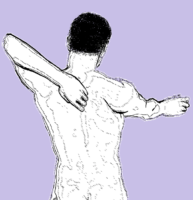5 SI Joint Dysfunction Pain Patterns – What Does This Pain Feel Like?

Are you dealing with a terrible back pain and no one seems to know why? The cause may be closer than you think – your sacroiliac joint.
But how does this pain feel like? Is it different of all the other back or hip pains? Today we’re digging deep into the problem. Here are the 5 SI joint dysfunction pain patterns, or how exactly feels the pain caused by this condition.
If you’re facing any of the things from above, don’t skip the following lines.
1. Over 7
In every health condition, the pain depends of the disease’s progress and state. However, most patients with SI joint dysfunction characterize the pain as being “very deep”.
It’s the kind of pain that keeps you away from everyday activities, and it usually goes away only with strong analgesics. The pain calms down while sitting, but it doesn’t go away completely (usually around a 5 or 6). Obviously, standing makes it worse.
In the initial stages of the disease, the pain appears progressively, going from a 2 to 4 and then gradually passing 7. So the pain produced by SI joint dysfunction will only worsen with time.

2. Burning And Sharp
If you want a practical description, the SI joint dysfunction pain feels like having your back and spine burning, especially in the lower part. Besides, the pain is very deep and sharp, no matter in what position you’re standing.
Laying down helps a lot, that’s true, but even moving can be painful in advanced stages of the disease. Each movement you make feels like being stabbed in the back, according to some patients.
Pain killers do help for a period, but after a while the disease progresses and you can’t control the pain anymore. Besides, your body starts tolerating them so you would need an increased dose, that can also be toxic.
3. Stiff
 Besides being very severe itself, the pain produces temporary stiffness, especially in the morning or after sitting down. The patient is unable to move, and that’s not because of the pain.
Besides being very severe itself, the pain produces temporary stiffness, especially in the morning or after sitting down. The patient is unable to move, and that’s not because of the pain.
Of course that not every form of SI joint dysfunction comes with this symptom, but if the disease isn’t controlled and treated, it can lead to this situation after some time.
The stiffness may be better or worse, but it usually appears in the lower part of the back. If you can’t straighten your back normally (that besides the terrible pain), SI dysfunction can be the cause.
4. Numbing Skin
This is a consequence of the high level the pain can reach in severe forms. Though it’s not a very common symptom and only a few patients reported it, numbing skin can happen in SI joint dysfunction.
Because of the deep, burning pain, that part of the back starts to become numb when you touch it. However, that’s just an impression because analysis revealed it is in a perfectly normal state.
Once the treatment is started and the pain begins to go away, the feeling of numbing skin also disappears.
5. Miraculously Goes Away With Injections
 The best way to know if you have SI joint dysfunction or not is to have an anesthesia solution injected straight there. The pain would go away in minutes, depending from case to case. If your form is severe, it would only decrease, but enough for you to feel a big difference.
The best way to know if you have SI joint dysfunction or not is to have an anesthesia solution injected straight there. The pain would go away in minutes, depending from case to case. If your form is severe, it would only decrease, but enough for you to feel a big difference.
Unfortunately, this procedure can only be made by a specialized doctor. But keep in mind that not all of them can do it, so some of them might send you to an even more specialized one.
The procedure itself isn’t very complicated, but it requires a lot of precision because the injection must be done exactly in the joint. If it’s done correctly, the pain will go away miraculously.
These Are The Main SI Joint Dysfunction Pain Patterns
In some cases, the SI joint dysfunction is only diagnosed after months or years of pain. The lower back pain and stiffness usually indicate a problem in the back, and in most cases, all analysis and MRIs turn out perfectly normal.
The patients are sent home with pain killers, but the pain only increases. Once all the other options are worn out, doctors start thinking it might be the SI joint.
Unfortunately, that’s what happens usually. The cases where the disease was immediately diagnosed are quite rare.
For this reason, if you notice your pain is very severe and analysis show nothing is wrong, ask your doctor to test you for SI joint dysfunction. Normally, he should not refuse you, since there doesn’t seem to be any other problem.
That can spare you of a lot of useless pain.




